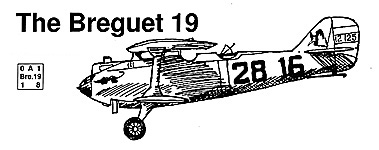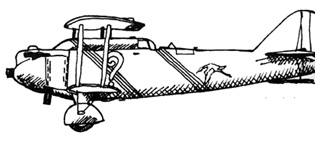The Breguet 19 was probably one of the oldest, if not the oldest, combat airplane to see action in World War Two. A two-seat
 reconnaissance/bomber biplane first flown in 1922, it was one of the most popular and widely manufactured aircraft between the First and Second World Wars. It was still in use in 1945, albeit in a very limited role in a very obscure comer of Europe. Its rating in For Whom the Bell Tolls gives it the distinction of having the lowest ratings of combat aircraft in Europa.
reconnaissance/bomber biplane first flown in 1922, it was one of the most popular and widely manufactured aircraft between the First and Second World Wars. It was still in use in 1945, albeit in a very limited role in a very obscure comer of Europe. Its rating in For Whom the Bell Tolls gives it the distinction of having the lowest ratings of combat aircraft in Europa.
The two-seat multipurpose aircraft was one of the most popular types to evolve during the First World War, and the Bre XIV was one of the best. After the war, the Breguet company was determined to build a more modem successor and to keep its place as one of the premiere French aircraft manufacturers. Thus design of the Bre 19 started in 1920. The aircraft featured duralumin framing for both the fuselage and the wings, instead of the more common wood construction. Two types were produced: the Bre 19A2, "Armee-biplace," reconnaissance aircraft; and the Bre 19B2, "Bombardment-biplane," light bomber. Both types were armed with one fixed forward firing machine gun, two rear firing machine guns on a flexible mount, and one firing aft through the bottom of the fuselage. The A2 model could also carry 10x 22lb bombs and the B2 up to 4x 220lb or 2x 440lb bombs. Both types could be fitted with a variety of engines, liquid-cooled or air-cooled, of varying sizes.
Tests
Tests of the prototype were a success, and the Bre 19 was ordered into production for the French "Aviation Militaire." The Breguet company also marketed the design abroad and received orders from Rumania, Russia, Turkey, Poland, Belgium, Argentina, Venezuela, Bolivia, Brazil, China, Belgium, Greece, Yugoslavia and Spain. Japan, Italy, Persia, and Great Britain obtained examples for evaluation. Some 1,800 aircraft were built by Breguet between 1922 and 1932, including the "second generation" Bre 19.7. This model was fitted with a more powerful engine and revised wing and tail of the long-range Bre 19s. 50 were sold to Turkey and 5 each to Rumania and Yugoslavia. License production of the Bre 19 took place in Belgium (146), Yugoslavia (425, including 125 of the Bre 19.7 model) and Spain (200).
Besides serving in the military role, Bre 19s were used for record long-distance flights by both military and civilian pilots during the twenties and thirties, flying from Paris to places like Tokyo, Peking, Basra, Omsk, and Madagascar. Redesignated as Bre 19 GRs ("Grand Raid," or "Long Endurance"), their fuel capacity was increased from 96 Imp.gal. to over 642 Imp.gal.
Later long-range types, nick-named "Bidons" or "Fuel Cans," featured increased wing area, a redesigned tail, and a fuel capacity of over 900 Imp.Gal. The most famous of the "Bidons," a Bre 19 GR "Super Bidon," named "Point d'Interrogation" (Question Mark), made the first non-stop flight from Paris to New York in 37 hours 18 minutes on 2 September 1930 to be welcomed at Curtiss Field by 25,000 people, including Charles Lindbergh.
By 1936, the Bre 19 was fast approaching obsolescence and had been phased out of first line service in France and most of the other countries in which it had been used. French Bre 19s were used in "pacification" operations in Morocco from 1928. Bolivian Bre 19s had been used in the first Chaco War against Paraguay in 1928-1929. The type had seen combat against the Japanese in Manchuria during the First Sino-Japanese War in 1931-1932 while serving in the air arm of the army of the warlord Marshal Chang Tso-lin.
On 18 July 1936, the Spanish "Avacion Militar Espanola" had some 135 Bre 19s still in service of the some 200 that had been license-built by CASA (Construcciones Aeronauticas SA) at its plant near Madrid between 1926 and 1935. Spanish Bre 19s were mainly powered by Spanish-built liquid-cooled engines. Prior to the start of the Civil War, the Popular Front government (the Republicans or Loyalists in FWtBT) had attempted to concentrate all serviceable aircraft around Madrid, but after the war started, some 63 Bre 19s found their way into Nationalist (the Insurgents in FWtBT) hands to serve Franco. After the start of the conflict, the Nationalists also acquired, via Portugal, some 20 ex-Polish Bre 19S.
Republican Bre 19s, including those in the "Escuadrilla Espana" which was commanded by French author Andre Malraux, attacked and routed a Nationalist column moving northward near Medellin on 20 August 1936. Later, Soviet engineers fitted additional forward firing machine guns to Republican Bre 19s which then made low level strafing attacks on Nationalist troops near Toledo. Other Bre 19s were used to attack the besieged Nationalist garrison at Alcazar. However the appearance of foreign fighters put an end to the Bre 19s' daylight attacks. When Spanishflown German He 51s made their combat debut on 18 August 1936, one of the four aircraft they shot down was a Republican Bre 19.
Nationalist Bre 19s were in action from the start of the war attacking Republican warships to divert them from a Nationalist convoy carrying Franco's men from North Africa to Spain. The Nationalist aircraft were later replaced by German He46Cs, dubbed "Pavas," or "Hen Turkeys," which, although a parasol monoplane of more recent vintage, was only marginally better. (FWtBT.- Loyalist Order of Battle Initial Forces, Jul II 36: 1x 0A1 1/8 Bre 19, withdraw Jul I 37; Insurgent Order of Battle Initial Forces, Jul II 36: 1x 0A1 1/8 Bre 19, withdraw May I 37).
By May 1937, both sides had retired their Bre 19s to training duties. Despite their age, few Bre 19s were lost during the war: 7 of 10 Nationalist and 18 of 28 Republican losses were due to combat. It was said that nobody ever got killed in a Breguet.
Italian Invasion of Greece
The end of the Spanish Civil War did not mean the end of the combat career of the Bre 19. At the start of the Italian invasion of Greece on 28 October 1940, the Elleniki Vassiliki Aeroporia (Royal Hellenic Air Force) still had 21 Bre 19s on strength of the 1 and 2 Mire Stratiokis Synergassias (Ground Support Squadrons), of which only about half were operational. During the first week of fighting, 2 Mira spotted and attacked the advancing Julia Division, losing two aircraft to C.R.42s. The squadron's surviving Bre 19s were destroyed in strafing attacks on 26 November 1940.
The Bre 19 had formed the mainstay of the Jugolovensko Kraljevsko Ratno VazduhopIovstvo or JKRV (Royal Yugoslav Air Force) in the twenties and thirties and was first line equipment as late as 1936 in all six air regiments. As late as I April 1940, 85 Bre 19 bombers and 75 Bre 19 reconnaissance planes were still serving in combat units. By 6 April 1941, when German forces crossed into Yugoslavia, Bre 19s (and Bre 19 variants, including the Bre 19.8, which was powered by the American Wright Cyclone radial engine) were still in first-line service with the seven Vazduhoplovna Izvidjacko Grupa (Air Reconnaissance Groups), one for each of the numbered Yugoslav Armies and one independent squadron assigned to the Coastal Army Command. Thirtythree more were with training units. JKRV Bre 19s were destroyed whole-sale on the ground and were sitting ducks for German fighters in the air. Despite this they attacked bridges used by the advancing Germans and strafed German panzer columns. Some 40 Bre 19s survived the fighting and were turned over to the Hrvatsko Zrakoplovstvo (Croatian Air Force), the air arm of the nominally independent but puppet Nezavisna Drzava Hrvatska or NDH (Independent State of Croatia). The Croats used them against Tito's partisans, and lost at least two to defection: one to the Partisans (later shot down) and one flown across the Adriatic to an Allied airbase in October 1943. At least two of the others survived until April 1945 and were used operationally by Tito's forces for communication and liaison duties until 1946.
The Bre 19 remained in operational service for over 25 years, a record for longevity shared by its parent company. The Breguet firm, started by Louis Breguet during World War One, and responsible for the Bre 690 series of light attack bombers which saw service in 1940, merged with Avions Marcel Dassault in 1969, builders of the famous Mirage, and thus remains in existence under the name of Dassault Aviation
Performance, Breguet 19B2
| Type: | two seat light bomber |
| Span: | 48 ft 8in |
| Length | 31 ft Alvin |
| Height | 10 ft 11.5in |
| Power plant: | 1 x 450hp Hispano Suiza 12Ha engine |
| Speed. | 141 mph |
| Range: | 500 miles |
| Service Ceiling: | 22,000 ft |
| Armament: | 1 x forward firing mg 2x flexible rear firing mgs 1 x ventral mg |
| Bomb Load: | 920lb |
Bibliography
"The Cadre Creator ... Heinkel's Last Fighting Biplane," Air Enthusiast 36 (May-August 1988)
Christienne, Charles & Pierre Lissarrague (translated by Frances Kianka), A History of French Military Aviation, Smithsonian Institution Press, 1986.
Emde, Heiner, Conquerors of the Air The Evolution of Aircraft 1903-1945, Bonanza Books, 1968.
Green, William, The Warplanes of the Third Reich, Garden City NY: Doubleday and Company, Inc., 1970.
Hooton, E. R., Phoenix Triumphant The Rise And Rise of the Luftwaffe, Arms and Armour Press, 1994.
Leyvastre, Pierre et al, "The Saga of the Ubiquitous Breguet," Air Enthusiast Seven (July-September 1978)
Shores, Christopher, Brian Cull and Nicola Malizia, Air War For Yugoslavia, Greece And Crete 1940-1941, Grub Street, 1987.
Taylor, Michael J. H., Warplanes of the World 1918-1939, Charles Scribner's Sons, 1981
Thomas, N. and K. Mikulan, Axis Forces in Yugoslavia 1941-5, Osprey Military Men-At-Anyis Series No. 282 (1995).

This civilian version of the Bre19 made the Atlantic crossing Paris to New York in 1930.
Back to Europa Number 62 Table of Contents
Back to Europa List of Issues
Back to MagWeb Master Magazine List
© Copyright 1998 by GR/D
This article appears in MagWeb (Magazine Web) on the Internet World Wide Web. Other military history articles and gaming articles are available at http://www.magweb.com